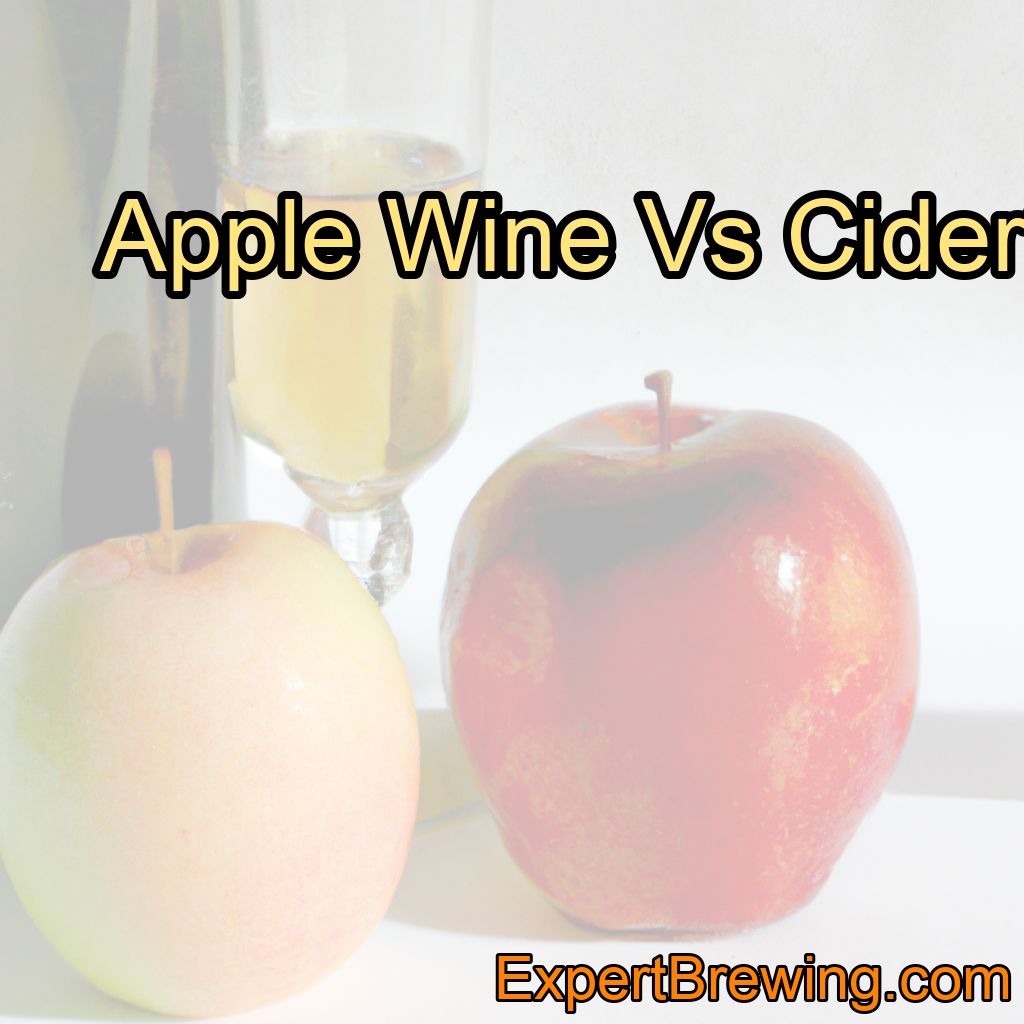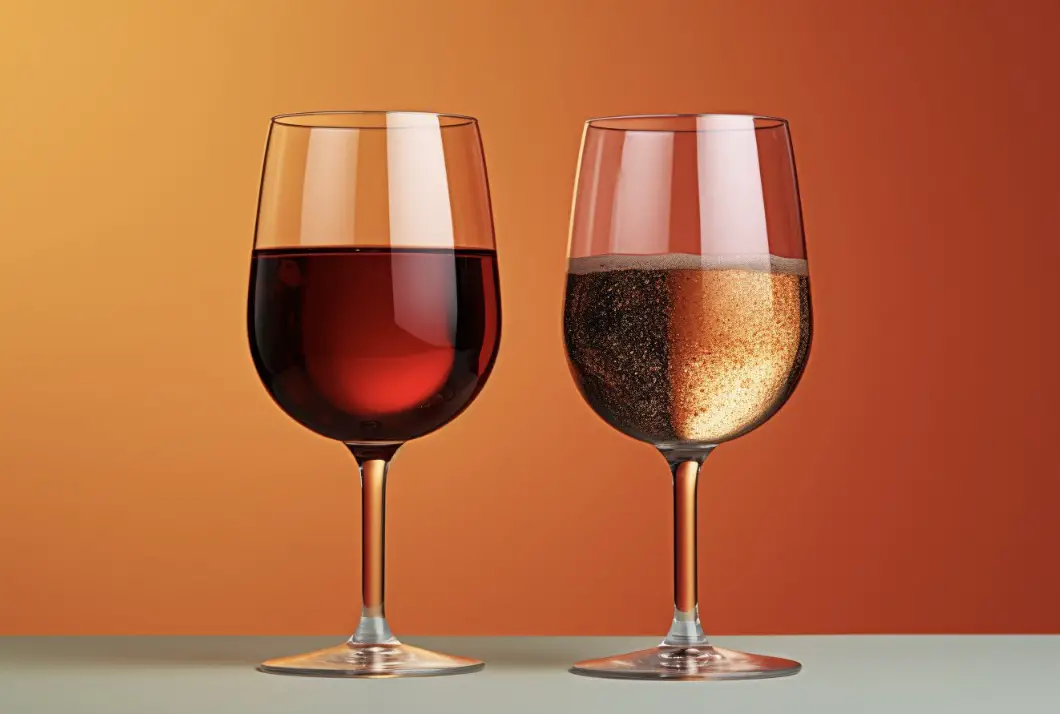As an expert brewer and a lover of all things fermented, I’ve had my fair share of apple-based beverages.
From sweet and bubbly ciders to complex and refined apple wines, I’ve tasted, brewed, and enjoyed them all.
In this blog post, I’ll delve into the differences between apple wine and cider, exploring their unique characteristics and brewing processes. By the end, you’ll have a deeper understanding of these delightful drinks and maybe even feel inspired to try your hand at making them yourself.
1. Definition and Basic Differences
Before diving into the intricacies of apple wine and cider, it’s essential to define the two and understand their basic differences.
Apple Wine
Apple wine, as the name suggests, is a type of fruit wine made by fermenting apples. It typically has a higher alcohol content compared to cider, usually between 10-15%. Apple wine is often made from a blend of apple varieties to achieve a balanced flavor profile. It is usually still (non-sparkling) and is often served as a dessert wine or enjoyed on its own.
Cider
Cider, or more specifically, hard cider, is an alcoholic beverage created by fermenting apple juice. The alcohol content of cider typically ranges from 4-8%, making it less potent than apple wine. Ciders can be sweet, dry, or anywhere in between, and they can be still, sparkling, or even served on tap like beer. The apple varieties used in cider production can be specific to cider-making or a blend of culinary apples.
Now that we’ve established the basic differences between apple wine and cider, let’s dive into their individual characteristics.
2. Flavor Profiles
Apple Wine
Apple wines are often characterized by their complex and layered flavors. The use of different apple varieties contributes to a diverse flavor profile, with notes of tartness, sweetness, and even some earthiness coming through. Apple wines can be dry or off-dry, with the sweetness level depending on the residual sugar left after fermentation.

The higher alcohol content in apple wine also contributes to a more robust and fuller-bodied mouthfeel, making it an excellent beverage to sip and savor.
Cider
Ciders, on the other hand, tend to have a more straightforward apple flavor profile. While there can be some variation in taste depending on the apple varieties used, ciders are generally known for their crisp, refreshing, and fruit-forward flavors. They can range from bone-dry to dessert-sweet, with the level of sweetness often determined by the fermentation process and the addition of any sweeteners. The lower alcohol content in cider makes it a more sessionable and easy-drinking beverage, perfect for enjoying on a warm day or with a meal.
3. The Brewing Process
Apple Wine
The brewing process for apple wine starts with selecting and pressing the apples. Most apple wines are made from a blend of apple varieties, so it’s crucial to choose apples that will provide a balanced flavor profile. The apples are then pressed to extract the juice, which is combined with sugar and water to reach the desired starting gravity (a measure of the sugar content in the liquid).
Once the juice is prepared, it’s time for fermentation. Wine yeast is added to the juice, and fermentation takes place at a controlled temperature to ensure a clean and consistent fermentation process. Fermentation can take anywhere from a few weeks to a few months, depending on the desired flavor profile and alcohol content. After fermentation, the apple wine is racked (transferred to a new container) and aged for an extended period, often several months to a year or more, to allow the flavors to meld and mature.
Cider
The cider-making process begins similarly to that of apple wine, with the selection and pressing of apples. However, cider apples are often used for their unique flavor profiles and higher tannin content, which contributes to the cider’s mouthfeel and complexity. Once the apples are pressed, the juice is collected and, depending on the desired final product, may be fermented with or without the addition of sugar.
Cider fermentation typically involves the use of either a specific cider yeast or a more general-purpose ale yeast. The fermentation temperature is usually cooler than that of apple wine, which helps retain the delicate apple flavors and aromas. Fermentation can take anywhere from a week to several months, depending on the desired final product. Once fermentation is complete, the cider may be racked and aged for a short period or bottled immediately, depending on the style and producer.
4. Appearance and Mouthfeel
Apple Wine
Apple wines are typically clear and still, with a pale to golden color depending on the apple varieties used and the length of aging. The mouthfeel of apple wine is generally fuller and more viscous than cider, owing to its higher alcohol content and residual sugar. The wine may also have a slight tannic structure, depending on the apple varieties used and the winemaking techniques employed.
Cider
Ciders can range in appearance from pale and clear to deep amber and hazy, depending on the apple varieties used and the production methods. Ciders may be still or sparkling, with some producers even offering ciders on tap with a beer-like carbonation level. The mouthfeel of cider is generally lighter and crisper than apple wine, with a more refreshing and easy-drinking quality.
5. Serving Suggestions and Food Pairings
Apple Wine
Apple wines are often served chilled, either as a dessert wine or as a standalone beverage to be savored and enjoyed. Their complex and layered flavors make them an excellent pairing for a wide range of foods, from sharp cheeses to rich desserts. Apple wines can also be used in cooking, adding a unique depth of flavor to sauces and glazes.
Cider
Ciders are best served cold and are a versatile beverage for food pairings. Their crisp and refreshing flavors make them an excellent match for a wide variety of dishes, from pub fare like fish and chips to more refined options like charcuterie boards and seafood dishes. Ciders can also be used in cooking, adding a bright and fruity element to recipes.
6. Popular Regions and Producers
Apple Wine
Apple wines are produced in various regions worldwide, with some of the most well-known coming from Germany, France, and the United States. Popular apple wine producers include Apfelwein Solzer (Germany), Domaine Dupont (France), and Warwick Valley Winery & Distillery (United States).
Cider
Cider production is prevalent in many regions globally, with some of the most famous cider-producing areas being England, France, Spain, and the United States. Notable cider producers include Aspall (England), Eric Bordelet (France), Sidra Trabanco (Spain), and Angry Orchard (United States).
7. Aging Potential
Apple Wine
Apple wines have the potential to age well, with some varieties and styles capable of developing and improving over several years. The higher alcohol content and residual sugar in apple wine can act as preservatives, allowing the wine to evolve and mature in the bottle. However, not all apple wines are meant for long-term aging, so it’s essential to research the specific wine in question and consult with the producer if possible.
Cider
Most ciders are meant to be enjoyed fresh and have a limited aging potential. However, some specialty ciders, such as those made from heirloom apple varieties or produced using traditional methods, may benefit from short-term aging. As with apple wine, it’s essential to research the specific cider in question and consult with the producer if possible.
8. Price and Availability
Apple Wine
Apple wines can vary in price depending on the producer, region, and production methods. Generally, apple wines can be found at a moderate price point, making them an accessible option for those looking to try something new. Availability may be limited depending on your location, but many specialty wine shops and online retailers carry a selection of apple wines.
Cider
Ciders are widely available and can be found at various price points, from budget-friendly options to more expensive, artisanal ciders. The increased popularity of craft cider in recent years has led to a surge in availability, with many bars, restaurants, and retailers now offering a diverse range of ciders to choose from.
9. Health Benefits and Considerations
Apple Wine
While apple wine does contain some antioxidants from the apples, the health benefits are likely limited due to the higher alcohol content and residual sugar. As with any alcoholic beverage, moderation is key, and it’s essential to enjoy apple wine responsibly.
Cider
Cider may offer some health benefits due to the presence of antioxidants and polyphenols found in apples. However, it’s essential to remember that cider is still an alcoholic beverage, and moderation is crucial. Additionally, some ciders may contain added sugars or sweeteners, which can impact overall health and calorie content.
10. Conclusion and Key Facts
In conclusion, both apple wine and cider offer unique and enjoyable drinking experiences, with the main differences lying in their flavor profiles, alcohol content, and production methods. To sum up the differences between apple wine and cider, here are ten key facts:
1. Apple wine has a higher alcohol content than cider (10-15% vs. 4-8%).
2. Apple wine is typically still, while cider can be still or sparkling.
3. Apple wine has a more complex and layered flavor profile compared to the more straightforward and fruit-forward flavors of cider.
4. The brewing process for apple wine involves a longer fermentation and aging period than cider.
5. Apple wine has a fuller mouthfeel than cider.
6. Apple wine is often served as a dessert wine, while cider is more versatile in food pairings.
7. Both apple wine and cider are produced worldwide, but they each have distinct regions and producers known for their excellence.
8. Apple wine may have some aging potential, while most ciders are meant to be enjoyed fresh.
9. Apple wines and ciders are available at various price points and levels of availability.
10. Both apple wine and cider contain some antioxidants from the apples, but moderation is key when considering health benefits and consumption.
Now that you have a deeper understanding of apple wine and cider, I encourage you to explore these delightful beverages further, whether by tasting, brewing, or simply learning more about their rich history and traditions. Cheers!
FAQs
Is apple wine a thing?
Yes, apple wine is a type of wine made from fermented apples. It is also known as hard cider in some regions.
Is apple wine real wine?
Yes, apple wine is a type of wine that is made from fermented apples, similar to how grape wine is made from fermented grapes. However, it is also commonly referred to as cider, which can cause confusion as cider can also refer to a non-alcoholic apple juice.
Are ciders healthier?
Ciders can be a healthier alternative to beer or wine because they are typically lower in alcohol content and calories, but it ultimately depends on the specific brand and ingredients used. Some ciders may contain added sugars or artificial flavors, which can negate any potential health benefits. It’s important to read the label and choose ciders made with natural, whole ingredients.
Has cider got more calories than wine?
Yes, cider generally has more calories than wine. A 5 oz glass of cider contains around 150 calories, while a 5 oz glass of wine contains around 120 calories. However, the exact number of calories can vary depending on the specific type and brand of cider or wine.
Are ciders healthier than wine?
Ciders and wine both contain antioxidants and can have health benefits when consumed in moderation, but the specific health benefits may vary depending on the type and quality of the beverage.
Is it healthier to drink wine or cider?
Both wine and cider can have health benefits when consumed in moderation. Wine is known for its antioxidant properties and potential benefits for heart health. Cider, on the other hand, can be a good source of vitamin C and other nutrients. Ultimately, the healthier choice depends on individual preferences and dietary needs. It is important to consume both in moderation and as part of a balanced diet.




